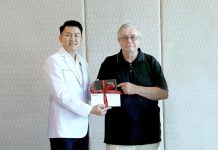Fairly ‘technical’ this week, but with Hep B killing three quarters of a million people each year, this is an important subject.
Dr Marc Pellegrini and Dr Greg Ebert from the Walter and Eliza Hall Institute of Medical Research in Melbourne, Australia have been awarded the Eureka Prize for Infectious Diseases Research for their work on the Hepatitis B virus.
Hepatitis B is a liver infection caused by the Hepatitis B virus (HBV). Hepatitis B is transmitted when blood, semen, or any another body fluid from a person infected with the Hepatitis B virus enters the body of someone who is not infected. This is called “horizontal” transmission. This can happen through sexual contact; sharing needles, syringes, or other drug-injection equipment; or from mother to baby at birth. For some people, hepatitis B is an acute, or short-term, illness but for others, it can become a long-term, chronic infection. Risk for chronic infection is related to age at infection: approximately 90 percent of infected infants become chronically infected, compared with 2 percent – 6 percent of adults. Chronic Hepatitis B can lead to serious health issues, like cirrhosis or liver cancer.
Vaccination against Hepatitis B has been possible for many years and is very effective. Despite vaccines, the prevalence of chronic HBV infection is highly variable, ranging from 0. 1 percent in the United States to 20-30 percent in some Pacific Island nations. There are an estimated 360 million people who are chronically infected, of whom almost one million people die annually of HBV-related liver disease. Chronic hepatitis B is the major cause of hepatocellular carcinoma in the world. So, despite the vaccine, Hep B remains a major health risk.
The highest rates of HBsAg (Hep B exposure) were found in women of Chinese origin (11.4 percent). This includes native Thais. Although mother to baby (vertical) transmission accounts for more than 50 percent of hepatitis B cases in Thailand, horizontal transmission in early childhood is also an important mode of transmission.
The Australian researchers have found a new use for an anti-cancer drug. It is being used to eliminate hepatitis B cells by telling infected cells ‘it’s time to die’ – switching off the cell’s resistance to programmed cell death that is part of a cell’s normal life cycle.
The new treatment has been developed by a team at the Walter and Eliza Hall Institute of Medical Research, led by Dr Marc Pellegrini and Dr Greg Ebert.
For research into the treatment of hepatitis B, Dr Pellegrini and Dr Ebert have been awarded the Prize for Infectious Diseases Research.
“This is important work addressing one of the world’s most widespread deadly diseases,” Kim McKay AO, Executive Director and CEO of the Australian Museum said.
“There is currently no cure for hepatitis B, which infects 2 billion people and causes 780,000 deaths a year,” she said.
Previous hepatitis B treatments have encouraged immune cells to attack infected cells, but an over-active immune system carries its own health risks. Instead, by targeting a particular protein, whose job it is to inhibit programmed cell death, the new treatment selectively targets liver cells that are infected with hepatitis B, bypassing healthy cells.
If this broad approach is successful, there is the potential that it may pave the way for the development of similar treatments to tackle other major chronic infections such as HIV and tuberculosis, which kill millions of people around the world each year.
Established in 1827, the Australian Museum is the nation’s first museum and one of its foremost scientific research, educational and cultural institutions. The Australian Museum Eureka Prizes are the most comprehensive national science awards, honoring excellence in Research and Innovation, Leadership, Science Communication and Journalism, and School Science.
As well as the Hep B research, a team comprising Professor Trevor Lithgow and Dr Hsin-Hui Shen (Monash University), Dr Denisse Leyton (Australian National University) and Dr Joel Selkrig (European Molecular Biology Laboratory) is very active. The team used biochemical and microbiology techniques to understand the function of a key molecular item that is required by bacterial pathogens to cause disease. This represents a novel target for the development of new therapeutics to treat infections caused by antibiotic-resistant superbugs.




